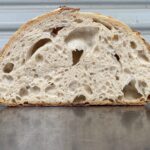
This recipe yields a flavorful, crusty loaf that’s perfect for sandwiches, toast, or spreads. Due to the long mix time and high hydration, it is imperative to use cold water to ensure proper gluten development and fermentation control.
Equipment
Ingredients (Amount – Bakers %):
Mixing speed and times may vary depending on the mixer. The following protocol has been adapted for a KitchenAid® or similar mixer using a dough hook attachment.
Get updates on new products and promotions!
©2025 Leaven Foods | Terms & Conditions | Privacy Policy | Cancellation Policy
Note: Enter the total flour and levain weights for accurate Levain calculations.